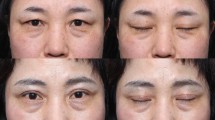Abstract
Background
Periorbital rejuvenation constitutes a common and much demanded claim. With aging face, fascial attachments and ligamentous supports become attenuated, and therefore, skin, orbicular muscle, malar fat and lateral eyebrow descend in middle-age women. Conventional facelift and standard blepharoplasty does not give an effective periorbital rejuvenation.
Methods
This technique was applied in 142 patients from 1999 to 2006 to treat periorbital aging. All patients were 35 to 55 years old, and 94.5% were female. Through an incision located in the hair line or inside the temporal portion of scalp, a wide subcutaneous dissection of temporal, forehead and eyelid areas was done. This allows undermining and suspension of the orbicularis oculis muscle with partial denervation and the concomitant treatment of crow’s feet, lateral muscular cantoplasty, elevation of the malar fat, superolateral traction of the eyebrow and resection of excess skin. Blepharoplasty or a conventional facelift was included if necessary.
Results
A total of 130 patients (91%) presented satisfactory results. In 16 patients (11 %) , partial infection of the temporal wound was detected; in other 12 (9 %), asymmetry of eyebrows was present, of which 9 (75%) corrected spontaneously after 3 months and in other 3 (25 %), a reoperation was necessary. No major complications were observed.
Conclusions
This technique allows a rational correction of all affected periorbital tissues, including forehead, eyebrow, eyelids, canthal ligaments, orbicularis muscle, malar fat and both periorbital and cheek skin with superior and superolateral vectors of traction. This is a safe and easy technique.









Similar content being viewed by others
References
Stuzin JM (2007) Restoring facial shape in facial-lifting: the role of skeletal support in facial analysis and midface soft tissue repositioning. Plast Reconstr Surg 119:362–376
Hamra ST (1996) The aging face: analysis, surgical approach, and result assessment. Aesth Surg Q 16:63–73
Hamra ST (1992) Composite rhytidectomy. Plast Reconstr Surg 96:354–362
Hamra ST (2001) Correcting the unfavorable outcomes following face-lift surgery. Clin Plast Surg 28:621–638
Byrd HS (1997) The extended brow-lift. Clin Plast Surg 24:233–246
Connel BF, Marten TJ (1993) Surgical correction of the crow’s feet deformity. Clin Plast Surg 20:295–302
Skoog T (1975) Plastic surgery. Saunders, Philadelphia
Aston H (1980) Orbicularis oculi muscle flaps: a technique to reduce crow’s feet and lateral canthal skin fold. Plast Reconstr Surg 65:206–216
Davis R, Anson B, Budinger J et al (1956) Surgical anatomy of the facial nerve and parotid gland based upon a study of 350 cervicofacial halves. Surg Gynecol Obstet 102:385–412
Correia P, Zani R (1973) Surgical anatomy of the facial nerve as related to ancillary operations in rhytidoplasty. Plast Reconstr Surg 52:549–552
Baker D, Conley J (1979) Avoiding facial nerve injuries in rhytidectomy: anatomical variation and pitfalls. Plast Reconstr Surg 64:781–795
Bernstein L, Nelson R (1984) Surgical anatomy of the extraparotid distribution of the facial nerve. Arch Otolaryngol 110:177–183
Guyuron B (1992) Subcutaneous approach to forehead, brow, and modified temple incision. Clin Plast Surg 19:461–476
Hinderer UT (1993) Correction of weakness of the lower eyelid and lateral canthus. Clin Plast Surg 20:331–349
Barton FE (1992) The periorbital dissection in rhytidectomy: how deep? Clin Plast Surg 19:455–459
Author information
Authors and Affiliations
Corresponding author
Rights and permissions
About this article
Cite this article
Guerrissi, J.O. Periorbital Rejuvenation: A Safe Subcutaneous Approach to Forehead, Eyebrow, and Orbicularis Oculis Muscle Mobilization. Aesth Plast Surg 34, 147–152 (2010). https://doi.org/10.1007/s00266-009-9356-6
Received:
Accepted:
Published:
Issue Date:
DOI: https://doi.org/10.1007/s00266-009-9356-6




